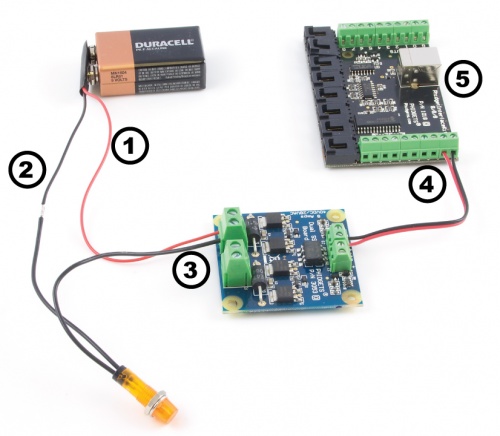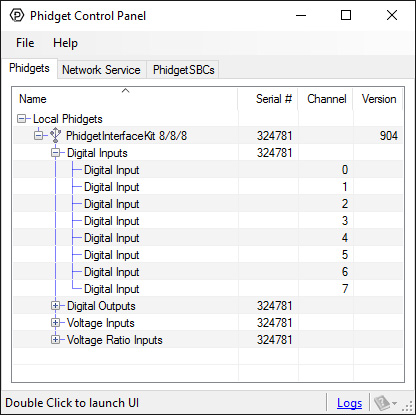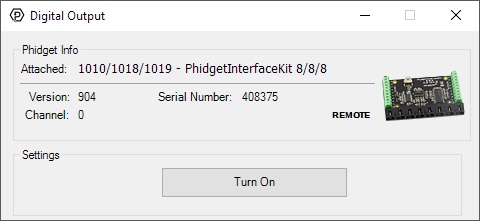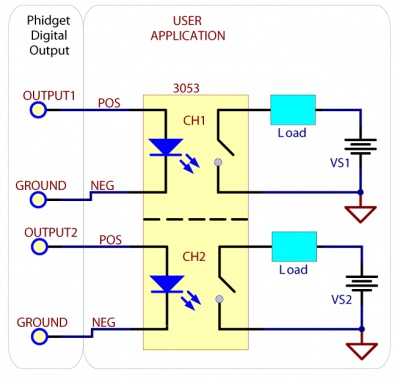3053 User Guide: Difference between revisions
No edit summary |
|||
| (25 intermediate revisions by 3 users not shown) | |||
| Line 1: | Line 1: | ||
__NOINDEX__ | |||
<metadesc>Phidgets' SSR Relay Board switches two SSRs rated for 28VAC/9amp or 40VDC/9amp using digital outputs.</metadesc> | |||
[[Category:UserGuide]] | |||
==Getting Started== | ==Getting Started== | ||
Welcome to the 3053 user guide! In order to get started, make sure you have the following hardware on hand: | |||
*[{{SERVER}}/products.php?product_id=3053 3053 - Dual SSR Relay Board] | |||
* Either the [{{SERVER}}/products.php?product_id=1018 1018] or [{{SERVER}}/products.php?product_id=OUT1100 OUT1100]. We will be using the [{{SERVER}}/products.php?product_id=1018 1018] for this guide. | |||
* USB cable and computer | |||
* {{CT|PhidgetCable|Phidget cable}} | |||
*something to use with the 3053 (e.g. a series circuit) | |||
Next, you will need to connect the pieces: | |||
[[Image:3053_0_Connecting_The_Hardware.jpg|500px|right|link=]] | |||
''' | # Connect the circuit to one of the load terminals of the 3053. | ||
# Attach the 3053 to your 1018 by connecting a wire from the terminal block marked with a '''+''' to a Digital Output and another wire from the terminal block marked with a '''-''' to any ground terminal on the 1018. | |||
# Connect the 1018 to your computer using a USB cable. | |||
''' | <br clear="all"> | ||
{{UGIntroDone|3053}} | |||
== | ==Using the 3053== | ||
{{ | {{UGcontrolpanelSensor|3053|1018}} | ||
||}} | |||
{{UGSensorDigitalOutput|This will change the relay state.}} | |||
{{ | |||
==Technical Details== | ==Technical Details== | ||
===General=== | |||
Solid State Relays, or SSRs, are devices designed to operate like standard relays but without mechanical motion. Built instead out of silicon transistors, SSRs allow currents and voltages to be switched by simple digital signals from a microprocessor or any other device that can supply the small amount of current needed to activate the SSR’s internal switching mechanism. For more information on solid state relays, refer to the [[Solid State Relay Guide|SSR Guide]]. | |||
===Using the SSR Board=== | |||
Using the SSR Relay Board in your application is typically done according to the diagram on the right, though there are other implementations for it as well. The SSR control inputs can be controlled with a wide range of voltage levels between 3 and 30V. Be sure to match the polarity of the control signal with the ± labels on the input terminal blocks. One concern with any type of relay is the turn-on and turn-off times. Since the SSR Board uses optoisolation, the turn-on delay depends on how strong the control signal is, while the turn-off delay is quite constant, and quick. The 3053 uses internal circuitry to keep the current of the control signal around 10mA, no matter how what voltage level is used. To improve the turn-on time of the SSR, a short current spike (approximately 35mA for 300μs) at turn-on is possible if your control signal can provide it. This allows the SSR to turn on quicker, reducing heating during the turn-on transition. If your control signal is not able to provide the 35mA, the SSR will turn on anyway, but will take up to 50% longer. | |||
[[File:3053_0_Diagram.jpg|400px|link=|center]] | |||
===Isolation and Protection Devices=== | |||
The SSR Board is safe to use with sensitive control devices like microprocessors, and will not damage a Phidget or your PC. This is achieved through the use of an optoisolation chip - creating a physical barrier between the SSR control inputs and the potentially high voltage and high current outputs. In addition to the optoisolation between the inputs and outputs, there is an on-board 47V voltage supression device | |||
across the relay output that protects the board from static electricity and surges from inductive loads. To protect the optoisolation LEDs from potential overcurrent on the inputs, a transistor-based current limiting circuit has been added. The circuit limits the constant current travelling through the LEDs to 10mA, regardless of the input voltage. The transistors dissipate what would have been extra current in the form of heat. The 3053 Dual SSR Board comprises of two channels. Both channels are electrically and physically isolated from each other, and are controlled individually. | |||
== | ====Warning==== | ||
The SSR Board is able to safely switch at a speed of 20Hz. This board is not intended as a high frequency switch due to the extreme heating that will occur. Although it is possible to switch the SSR Board at up to 300Hz, it easily produces enough heat to liquefy the solder underneath the transistors (which requires at least 240°C) at a 3A load. | |||
=== | |||
{{UGnext|}} | |||
{{ | |||
Latest revision as of 19:52, 1 June 2023
Getting Started
Welcome to the 3053 user guide! In order to get started, make sure you have the following hardware on hand:
- 3053 - Dual SSR Relay Board
- Either the 1018 or OUT1100. We will be using the 1018 for this guide.
- USB cable and computer
- Phidget cable
- something to use with the 3053 (e.g. a series circuit)
Next, you will need to connect the pieces:

- Connect the circuit to one of the load terminals of the 3053.
- Attach the 3053 to your 1018 by connecting a wire from the terminal block marked with a + to a Digital Output and another wire from the terminal block marked with a - to any ground terminal on the 1018.
- Connect the 1018 to your computer using a USB cable.
Now that you have everything together, let's start using the 3053!
Using the 3053
Phidget Control Panel
In order to demonstrate the functionality of the 3053, we will connect it to the 1018, and then run an example using the Phidget Control Panel on a Windows machine.
The Phidget Control Panel is available for use on both macOS and Windows machines. If you would like to follow along, first take a look at the getting started guide for your operating system:
Linux users can follow the getting started with Linux guide and continue reading here for more information about the 3053.
First Look
After plugging in the 3053 into the 1018, and the 1018 into your computer, open the Phidget Control Panel. You will see something like this:

The Phidget Control Panel will list all connected Phidgets and associated objects, as well as the following information:
- Serial number: allows you to differentiate between similar Phidgets.
- Channel: allows you to differentiate between similar objects on a Phidget.
- Version number: corresponds to the firmware version your Phidget is running. If your Phidget is listed in red, your firmware is out of date. Update the firmware by double-clicking the entry.
The Phidget Control Panel can also be used to test your device. Double-clicking on an object will open an example.
Digital Output
Double-click on a Digital Output object in order to run the example:

General information about the selected object will be displayed at the top of the window. You can also experiment with the following functionality:
- Toggle the state of the digital output by pressing the button. This will change the relay state.
Technical Details
General
Solid State Relays, or SSRs, are devices designed to operate like standard relays but without mechanical motion. Built instead out of silicon transistors, SSRs allow currents and voltages to be switched by simple digital signals from a microprocessor or any other device that can supply the small amount of current needed to activate the SSR’s internal switching mechanism. For more information on solid state relays, refer to the SSR Guide.
Using the SSR Board
Using the SSR Relay Board in your application is typically done according to the diagram on the right, though there are other implementations for it as well. The SSR control inputs can be controlled with a wide range of voltage levels between 3 and 30V. Be sure to match the polarity of the control signal with the ± labels on the input terminal blocks. One concern with any type of relay is the turn-on and turn-off times. Since the SSR Board uses optoisolation, the turn-on delay depends on how strong the control signal is, while the turn-off delay is quite constant, and quick. The 3053 uses internal circuitry to keep the current of the control signal around 10mA, no matter how what voltage level is used. To improve the turn-on time of the SSR, a short current spike (approximately 35mA for 300μs) at turn-on is possible if your control signal can provide it. This allows the SSR to turn on quicker, reducing heating during the turn-on transition. If your control signal is not able to provide the 35mA, the SSR will turn on anyway, but will take up to 50% longer.

Isolation and Protection Devices
The SSR Board is safe to use with sensitive control devices like microprocessors, and will not damage a Phidget or your PC. This is achieved through the use of an optoisolation chip - creating a physical barrier between the SSR control inputs and the potentially high voltage and high current outputs. In addition to the optoisolation between the inputs and outputs, there is an on-board 47V voltage supression device across the relay output that protects the board from static electricity and surges from inductive loads. To protect the optoisolation LEDs from potential overcurrent on the inputs, a transistor-based current limiting circuit has been added. The circuit limits the constant current travelling through the LEDs to 10mA, regardless of the input voltage. The transistors dissipate what would have been extra current in the form of heat. The 3053 Dual SSR Board comprises of two channels. Both channels are electrically and physically isolated from each other, and are controlled individually.
Warning
The SSR Board is able to safely switch at a speed of 20Hz. This board is not intended as a high frequency switch due to the extreme heating that will occur. Although it is possible to switch the SSR Board at up to 300Hz, it easily produces enough heat to liquefy the solder underneath the transistors (which requires at least 240°C) at a 3A load.
What to do Next
- Programming Languages - Find your preferred programming language here and learn how to write your own code with Phidgets!
- Phidget Programming Basics - Once you have set up Phidgets to work with your programming environment, we recommend you read our page on to learn the fundamentals of programming with Phidgets.
